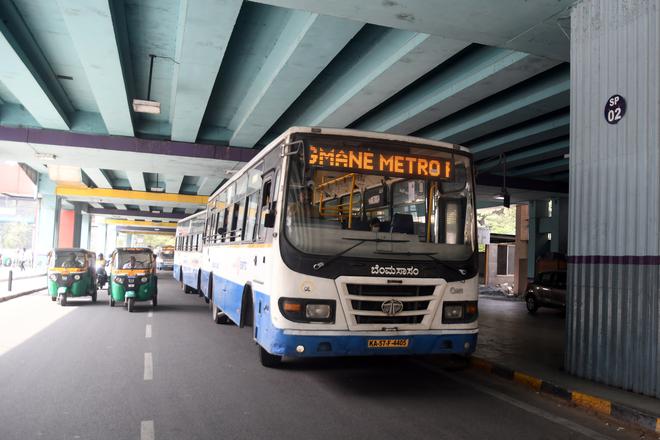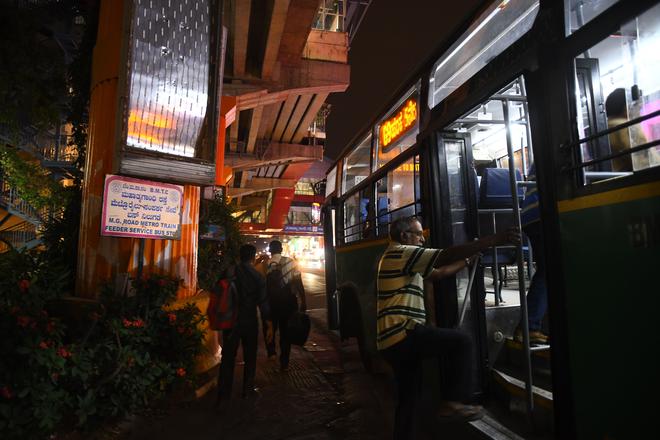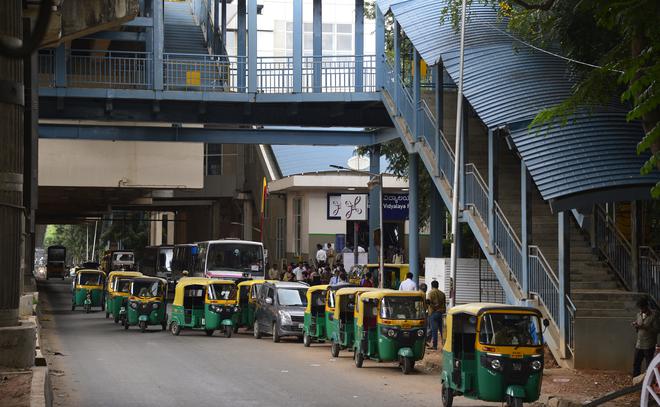Radha Nayak, a corporate-sector employee in Bengaluru, who has relied on the metro for her commute for the last seven years, still encounters a big challenge — last-mile connectivity. “Commuting from home at Chikkabanavara in North Bengaluru to the office in Halasuru in the central business district [about 20 km] takes two hours, despite taking the metro. The last-mile connectivity issue arises while going from Chikkabanavara to Nagasandra or Dasarahalli metro station [about 5 km] where I have to take a bus,” she says, adding that the bus journey takes half an hour during peak hours. “If the buses are crowded, I am forced to take an autorickshaw. If there were more buses on this route, I could travel more efficiently,” Radha says.
With the inception of the metro service in Bengaluru in 2011, spanning a 6.7-km stretch, commuters anticipated a respite from the city’s perpetual traffic snarls. Now in 2023, the metro network has grown to encompass 73.75 km. However, the persisting problem of inadequate first- and last-mile connectivity has led to a surge in the use of personal vehicles, contributing to the worsening traffic situation. The number of private vehicles in the city which spans 700-odd sq. km continues to escalate and has surpassed 10 million.
Since the launch of the Shakti scheme — which allows free bus rides for women in State-run transport corporation buses — by the Karnataka government on June 11 this year, lakhs of women have started using buses across the State. The success of the scheme is evident in cities such as Bengaluru. It has registered 100 crore free rides so far in the State. Additionally, the opening of the entire Purple Line of Namma Metro from Challaghatta in the west to Whitefield in the east has contributed to an increase in metro ridership, averaging 7,66,880 passengers a day.

Personal to public
The first- and last-mile connectivity, however, remains a major issue. Experts say it is important to resolve this to realise the full potential of the metro and bus network. In partnership with the World Resources Institute (WRI), the citizens’ group Bangalore Political Action Committee recently launched the #Personal2Public campaign, aiming to deter individuals from using personal vehicles.
As part of this initiative, the Bengaluru Metropolitan Transport Corporation (BMTC) introduced feeder bus services to establish connectivity between major tech corridors, including the Outer Ring Road (ORR), and metro stations. “Routes were launched connecting Hoodi Metro Station to K.R. Puram, J.P. Nagar station to J.P. Nagar 7th Phase, Jayanagar 9th Block round trip, Banashankari to BTM Layout (Kuvempunagar), Chikkabanavara to Nagasandra, K.R. Pura Metro Station to Central Silk Board, catering to commuters in the tech corridor of the Outer Ring Road and Kadugodi,” a senior BMTC official says.
The #Personal2Public campaign conducted a survey to understand commuting patterns. The findings indicate that metro users generally spend less than 45 minutes on their primary mode of transport. However, when accounting for first- and last-mile connectivity, the average travel time extends to approximately one to one-and-a-half hours.

As of August 28 this year, up to 3,855 people had participated in the feedback collection initiative for the survey, with 9.7% identifying as metro users, 9% as bus users, and a significant 81.3% falling into the non-user category.
“Many studies confirm that the majority of commuters of Bengaluru are eager to switch to public transport from their personal vehicles to save time and avoid driving stress, but the last mile continues to be a hurdle,” says Srinivas Alavilli, a fellow at the WRI India, a research organisation. He adds that #Personal2Public is trying to address this complex problem by bringing together civic groups and corporate houses to work with government agencies such as Bangalore Metro Rail Transport Corporation Ltd. (BMRCL), the BMTC, and the Bruhat Bengaluru Mahanagara Palike (BBMP) that administers the city. “As the metro network expands and suburban trains build out, we need to reimagine mobility in our city with walking and cycling as key elements along with autos and buses acting as feeders to buses, metros, and trains,” he says.
Transport Minister Ramalinga Reddy says, since buses are one of the most effective solutions to enhance last-mile connectivity, “The BMTC is increasing the number of feeder bus services in the city, with a particular focus on connecting metro stations. Currently, 38 buses, including both AC and non-AC, are operational on four new feeder routes. These routes aim to connect more people to the metro, especially employees of companies located along the ORR and those located in the city’s eastern and south-eastern regions.”
Autorickshaws and cabs
Common on Bengaluru’s streets, the autorickshaw was meant to be the best option for short-distance travel. However, the absence of an efficient pricing system has led to issues with the auto meter, contributing to an unsustainable increase in the number of people relying on private vehicles in the city.
Pre-paid autorickshaw stands at several metro stations are not functioning well. Despite the high rate cards, vehicles are frequently not available, and the counters are either inadequately staffed or closed. “After stepping out of the metro station, we have tough negotiations with auto drivers over fares and often end up paying more. During peak hours, the waiting time for Uber or Ola auto can be frustratingly long,” says Punita Sharma, a resident of Indiranagar in East Bengaluru. She wishes the authorities would regulate autos better.

People also often complain about the auto drivers’ behaviour. However, Sampath C., general secretary of the Adarsh Auto Drivers’ Union, says that the blame also falls on driving schools and the Regional Transport Offices. “After getting the learner’s licence, the driver has a 30-day window to acquire a driving licence,” he says. He feels this time should be used to communicate that the licence is given for public service, and the driver should be available for hire from any part of the city, and behave like any public servant.
Cabs are generally more expensive than autos and, according to commuters, are no longer reliable or economical for last-mile connectivity. Sandesh Rao, a tech professional from Whitefield, a hub of IT companies, says, “Carpooling is an efficient way to utilise cab services as it significantly reduces costs. However, the government has banned it.”
Walking and cycling
The most economical and eco-friendly option is to promote walking and cycling access to buses and the metro. However, the absence of dedicated cycle lanes and secure cycle parking facilities at metro stations poses challenges for cyclists in the city. The Directorate of Urban Land Transport has deployed 200 bicycle slots at nine metro stations and 11 BMTC Traffic Transit Management Centres (TTMCs) to enable first- and last-mile connectivity to public transport.
“We are now trying to popularise the facilities provided by the authorities, and enable people to discover safe routes to reach the stations,” says Sathya Sankaran, Bicycle Mayor of Bengaluru and founder of the collective Council for Active Mobility.
In Bengaluru, where there are approximately 14,000 km of roads, only about 50 km have well-maintained footpaths, according to experts. “There should be a focus on pedestrianisation. In the city, aside from footpaths of TenderSURE roads built in the central business district areas, the quality of most pavements is poor. How can people walk under these conditions? Now the authorities should focus on three things — footpaths, cycle lanes, and good roads which will help in achieving the last-mile connectivity,” traffic expert M.N. Sreehari says.
Lack of central planning authority
The lack of seamless access among different modes of travel in the city propelled the Karnataka government to constitute the Bengaluru Metropolitan Land Transport Authority (BMLTA) for the regulation of development, operation, maintenance, monitoring, and supervision of urban mobility within the Bengaluru metropolitan area.
The authority to be headed by the Chief Minister will have 34 members, including two special invitees, and 10 non-bureaucrat members, including the Transport Minister, the Bengaluru Development Minister, and heads of various departments. Experts and citizen representatives will also be part of the authority, which will be aided by an executive committee headed by the Chief Secretary.
It will bring agencies, such as the BMTC, the BMRCL, the traffic police, the BBMP, and the Bangalore Development Authority under one umbrella. In 2022, both the Houses of the Karnataka legislature passed the BMLTA Bill and the State government notified the BMLTA in January 2023. However, the authority is yet to become functional.
Alavilli says that the lack of a central planning authority like the BMLTA is hindering progress on the last-mile connectivity front. “We are not witnessing better integration between the metro and the BMTC, despite the BMTC’s aggressive plan to expand its feeder services across the city. People have a key role to play in any transformation and I hope the citizens of Bengaluru will rise to the occasion and switch to public transport at least twice a week.”







